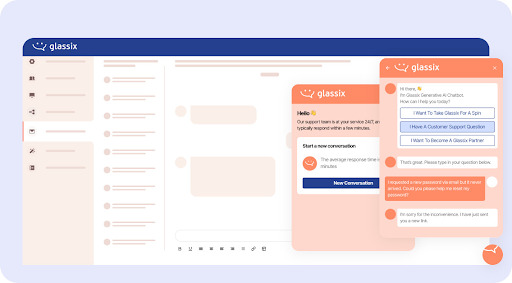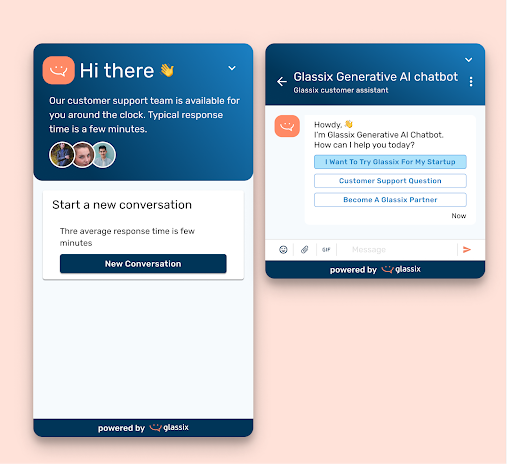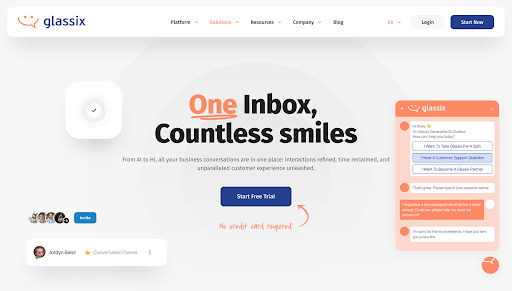#AI Chatbot for Business
Explore tagged Tumblr posts
Text
My AskAI Review: The AI-Powered Customer Support Solution Businesses Need
My AskAI Review: The AI-Powered Customer Support Solution Businesses Need Introduction: Is My AskAI the Future of Customer Support? In today’s fast-paced digital world, businesses need quick, efficient, and cost-effective solutions to manage customer inquiries. Traditional customer support methods—like call centers and email tickets—often lead to long wait times, high costs, and frustrated…
#24/7 AI chatbot#AI chatbot for business#AI chatbot integration#AI chatbot with human handover#AI for business efficiency#AI for customer engagement#AI support tool for small businesses#AI-driven customer experience#AI-powered customer support#AI-powered help desk#automated customer service#best AI chatbot 2024#best AI customer support tool#improve customer support with AI#My AskAI#My AskAI features#My AskAI pricing#My AskAI pros and cons#My AskAI Review#reduce support costs with AI
0 notes
Text
How Reputation Management Tools Help Businesses Stay Ahead of Competitors
In today’s digital-first world, a company’s online reputation can make or break its success. With customers increasingly relying on reviews, ratings, and social media for purchasing decisions, managing your brand’s reputation is more important than ever. Reputation management tools offer businesses a powerful way to monitor and improve their public image, ensuring they stay ahead of competitors in an increasingly crowded marketplace.
The Role of Reputation Management Tools
A reputation management tool helps businesses track and improve their online presence by monitoring reviews, mentions, and feedback across various digital channels. Whether it’s a review site, social media platform, or customer feedback form, these tools centralize all this information in one place, allowing businesses to stay on top of their brand image.
By using reputation management tools, businesses can respond promptly to both positive and negative feedback. Timely engagement with customers builds trust and shows a commitment to improvement. In a competitive market, this kind of proactive reputation management can differentiate a brand from its competitors who may not be as responsive or diligent in addressing feedback.
Gaining a Competitive Edge with AI Chatbots
As competition in almost every industry continues to intensify, businesses are turning to AI chatbots for business to automate and streamline their customer interactions. An AI-powered chatbot can provide real-time support to customers, answer frequently asked questions, and even guide users through the purchase process. With these tools, businesses can ensure they offer a consistent, 24/7 experience for their customers.
From a reputation management perspective, chatbots can also help businesses gather real-time feedback on customer experiences, allowing companies to address issues before they escalate into negative reviews. By providing prompt and helpful responses, businesses can significantly improve customer satisfaction, thus enhancing their reputation and staying ahead of the competition.
WhatsApp Chatbots: Direct Communication with Customers
Another innovative tool that can aid reputation management is a WhatsApp chatbot. WhatsApp, with its massive global user base, has become a preferred communication channel for businesses and customers alike. Using a WhatsApp chatbot, businesses can interact directly with customers, offer support, and even resolve complaints in real-time. This direct line of communication not only improves customer service but also helps businesses manage their reputation more effectively.
A WhatsApp chatbot allows businesses to handle customer inquiries efficiently, ensuring that no request goes unanswered. This level of customer engagement fosters loyalty and trust, making it easier for businesses to retain customers. In contrast, competitors who lack such tools may struggle to offer the same level of personalized service, giving businesses with chatbots a clear advantage in terms of reputation and customer satisfaction.
Real-Time Feedback and Issue Resolution
One of the most significant advantages of using reputation management tools, along with AI chatbots and WhatsApp chatbots, is the ability to gather real-time feedback from customers. By actively monitoring customer sentiment and addressing concerns promptly, businesses can prevent small issues from turning into major reputation-damaging crises.
For example, if a customer leaves a negative review or expresses frustration on social media, businesses can use their reputation management tool to respond instantly. By offering a resolution quickly, such as a refund, exchange, or apology, companies can turn a negative experience into a positive one, showing their commitment to customer satisfaction. This level of responsiveness can be a game-changer in outpacing competitors who may not have the tools or the agility to address problems in real-time.
Staying Proactive, Not Just Reactive
Reputation management is not just about reacting to problems — it’s about staying proactive and shaping the narrative around your brand. By using reputation management tools in conjunction with AI-driven solutions like chatbots, businesses can anticipate customer needs and address potential issues before they become significant. Whether it’s acknowledging positive reviews or responding to negative feedback, maintaining a consistent and proactive approach is key to staying ahead of competitors.
Moreover, AI chatbots can help businesses gather valuable insights from customers, allowing them to improve products, services, and overall customer experience. This forward-thinking approach ensures that businesses not only stay ahead of their competitors in terms of reputation but also continuously improve their offerings to meet customer expectations.
Conclusion
In an age where online reputation is everything, businesses must take active steps to monitor and manage their public image. Reputation management tools, combined with AI-powered chatbots for business and WhatsApp chatbots, allow companies to stay on top of customer feedback, respond to issues in real time, and provide an unparalleled customer experience. This combination of automation and engagement gives businesses the competitive edge they need to thrive in today’s fast-paced digital world. By embracing these tools, businesses can build a strong, positive reputation that sets them apart from competitors and fosters long-term success.
0 notes
Text

Empowering Every Industry with UMENBot. We infuse AI into your business. UMENBot is your gateway to embracing the future of Artificial Intelligence, opening new doors for growth and innovation
1 note
·
View note
Text
Top 3 use-cases of AI chatbots in the automobile industry
The automobile industry is extremely competitive as car buyers of today have quite an expansive variety of options to make their choice from. Hence, rather than simply using typical, pushy sales pitches, automobile brands must innovate and use AI chatbot for business. AI powered chatbots can help companies to provide seamless assistance to the customers both before and after sales, gain a competitive advantage and enjoy easier conversions.
The world is shifting towards an era of an experience economy. In the current age, customers do not just purchase things, rather they pay for experiences. No customer today would prefer to wait for half an hour just for a quick inquiry from a salesperson. Hence, automobile brands that really want to win customers must seek out assistance of a good AI chatbot company, and employ a dependable chatbot for their business.
There are some of the major use-cases of AI chatbots in the automobile industry:
Attending customers and answering their questions: Hiring and maintaining a customer service or support team can be pretty expensive. However, if AI chatbot are used to interact with customers, a company is unlikely to need too many human agents. Due to the increasing competition in the industry, automobile brands have to be quick with their responses. They cannot leave customers waiting as they try to seek product information and other details. Fortunately, AI enabled chatbots can attend to customer queries at all times, while also reducing the costs associated with hiring human agents.
Scheduling test drives: It can be quite a mundane task for company employees to take customer data of the people who want to take a test drive and subsequently schedule the activity. This task can be easily completed without any human intervention after employing chatbots. An AI chatbot can collect the relevant data and schedule a test drive for the customers.
Offering purchase assistance: Cars are an expensive asset, and hence buyers take a lot of care when buying such an item. Most customers seek out a lot of information once they decide to purchase a vehicle. They are likely to have queries about what would be the on-road price, what are the EMI options, what are the available colors and so on. All of these queries can instantly be answered by a chatbot. These bots allows automobile brands to be available 24x7 to assist the customers, and facilitate a smooth purchase process.
Any automobile company and even car dealerships can benefit from AI chatbots.
0 notes
Text

As businesses, we know that providing exceptional #customerservice is crucial to building strong relationships & driving growth. But, are you using the right strategies to deliver #omnichannel customer service? Discover the benefits of omnichannel customer service, including increased #customersatisfaction, loyalty, & retention.
Check out our blog post to learn how: https://www.vitelglobal.com/blog/omnichannel-customer-service/
#CustomerService#CustomerExperience#Business#technology#omnichannelmarketing#digital#ai#digitaltransformation#contactcenter#chatbot#innovation#businessstrategy#cloud#multichannel#strategy
7 notes
·
View notes
Text
300 ways to make money with chatgpt

#chatgpt search#tumblr milestone#sell products#business#findyourthing#money#a.i#make money for free#chatgpt plus#startup#chatgpt prompts#artists on tumblr#ai technology#artificial intelligence#chatbots
3 notes
·
View notes
Text
ORA ULTIMA 🆘 DeepSeek: un'IA cinese pronta a sbaragliare i colossi USA? Scopri perché! https://www.oraultima.com/intelligenza-artificiale-deepseek/
🆘 Una startup cinese, DeepSeek, ha sviluppato un chatbot AI che sta sconvolgendo il mercato. Con pochi chip, ha raggiunto prestazioni paragonabili ai colossi americani, mettendo in discussione il loro dominio. Ma quali sono le implicazioni di questa svolta? Visita il sito ORA ULTIMA per scoprire come DeepSeek sta cambiando le regole del gioco dell'intelligenza artificiale e quali sono le prospettive future. Cosa ne pensi di questa nuova sfida? Condividi la tua opinione!
❓E tu, Cosa ne pensi di questa nuova sfida? Condividi la tua opinione! Partecipa alla discussione sui nostri social! Commenta qui sotto 👇
💡Vuoi rimanere sempre aggiornato sulle ultime novità nel mondo dell'economia e della finanza? Visita ogni giorno https://www.oraultima.com/ per scoprire analisi approfondite, interviste esclusive e le notizie più importanti che stanno cambiando il mondo.
#oraultima #28gennaio #Nvidia #DeepSeek #AI #Cina #Nasdaq #tech #mercati #investimenti #tecnologia #socialmedia #privacy #economia #finanza #economy #finance #Italia #Notizie #money #news #notizie #business
3 notes
·
View notes
Text

Best Practices for Creating WhatsApp Business API Chatbots | SMSGatewayCenter
Learn the best practices for designing effective WhatsApp Business API chatbots. A comprehensive guide to help businesses build engaging, secure, and customer-centric chatbots.
#WhatsApp Business API#chatbot design#best practices#WhatsApp chatbots#AI-powered chatbots#business communication#WhatsApp automation#customer service chatbot#interactive chatbots#secure chatbots
3 notes
·
View notes
Text

BotSailor stop your Customer losing for no effort Chatbot Integration .
#ai chatbot#whatsapp chatbot#comics#b2b saas#saas#software#whatsapp#whatsapp api#marketing#technology#business#saas development company#saas platform
2 notes
·
View notes
Text
Pro-AI folks rightly point out that it doesnt actually take a bottle of water for a single AI query
Then promptly use that to ignore the fact that LLM training has pushed Google and other AI developers from breaking climate promises they made in terms of energy usage and water usage. Training new models is intensely energy expensive, and has driven huge ecological impacts, and ignoring that bc someone else on the internet made a poor argument is not good. Like there are real and huge problems here. And water usage is one of them, even if it’s not as intense as the equivalent of a water bottle per query.
#also i think part of the reason so many business folks are pushing AI so hard is bc LLM chatbots can actually write better than them#but that’s not a reason to cut your copywriters lmao#it’s like thinking you can get rid of actuaries and accountants bc you have excel
3 notes
·
View notes
Text
haha do you guys remember when AI was just a terms for how the computer players in video games did things haha takemebacktakemebacktakemeback
#cyus.jpeg#GOD why do i have to be afraid of a MACHINE to get a job as a fucking VOICE ACTOR#@everyone (on earth) STOP USING AI VOICES. NOT ONLY DO THEY RUN VOICE ACTORS OUTTA BUSINESS BUT IT CAN ALSO GET PEOPLE IN TROUBLE#FOR THINGS THAT THEY NEVER SAID#STOP USING AI CHATBOTS TOO. LEARN TO WRITE. OR START ROLEPLAY OR SOMETHING. *PLEASE*
11 notes
·
View notes
Text

Hey everyone! 🌟
I wanted to share something pretty cool that I’ve been using lately: Omodore, an AI assistant that's really made a difference in how we do things at work. I thought I’d give you a quick rundown of my experience with it.
So, first things first, setting up Omodore was super easy. I’m not a tech wizard, but I managed to get everything up and running without any headaches. In no time, we had our AI assistant ready to help out with daily tasks.
One of the best things about Omodore is how it handles customer service. It’s like having an extra pair of hands (or a brain, really). It answers common questions, takes orders, and makes sure our customers get what they need quickly. It’s been a lifesaver, especially during busy times.
Our HR team has also found Omodore super helpful. It handles repetitive tasks like scheduling interviews and answering employee questions, which frees up time for more important things. This has improved our overall productivity and employee satisfaction.
And of course, data security is a big deal for us, and Omodore doesn’t disappoint. It uses strong security measures to keep our data safe, which is really reassuring.
All in all, Omodore has made our work life a lot smoother and more efficient. Whether you’re in customer service, HR, or other fields, Omodore has something to offer. If you’re looking to make things easier and more efficient at your workplace, I highly recommend giving Omodore a try. It’s more than just an AI assistant; it’s like having a super helpful coworker who never sleeps.
Try it out here: omodore.com
4 notes
·
View notes
Text
Essential Tools and Technologies for Effective Omnichannel Customer Support
In today’s competitive landscape, omnichannel customer service is essential for meeting customer expectations across multiple touchpoints. This approach allows businesses to deliver consistent and seamless experiences, whether customers interact through social media, chat, email, or phone. For an effective omnichannel strategy, leveraging the right tools and technologies is crucial. Here’s a look at the must-have solutions:
1. AI Chatbots for Business
AI chatbots have become vital for providing instant responses and 24/7 support, enhancing customer satisfaction and retention. An AI chatbot for business can help address common customer queries, route complex issues to human agents, and improve response times. With the ability to personalize interactions based on previous conversations, chatbots ensure a cohesive experience across channels. They not only save valuable time for customer service teams but also help in boosting customer engagement.
2. Customer Experience Management (CXM) Platforms
A customer experience management platform is essential for collecting and analyzing customer data from various touchpoints. By integrating customer insights across channels, a CXM platform enables businesses to understand customer preferences, pain points, and satisfaction levels. This comprehensive data helps companies improve the customer journey, providing valuable insights for refining their omnichannel customer service strategy. CXM platforms also facilitate personalized interactions, which is key to meeting customer expectations in an omnichannel environment.
3. Unified Communication Platforms
Unified communication tools allow seamless switching between channels — enabling customers to start a conversation on one channel (e.g., social media) and continue it on another (e.g., email) without losing context. These platforms integrate phone, chat, email, and social media, providing a holistic view of the customer’s history and interactions. They streamline communication for customer service teams, enhancing efficiency and ensuring consistency across channels.
4. CRM (Customer Relationship Management) Systems
An effective CRM system centralizes customer data, ensuring that all customer-facing teams have access to the same information. This alignment allows agents to provide informed, personalized assistance across various channels, contributing to a positive customer experience. CRMs also support omnichannel strategies by offering analytics that highlight customer trends, enabling businesses to anticipate needs and respond proactively.
5. Analytics and Reporting Tools
For ongoing success in omnichannel customer service, analytics tools are essential. These solutions measure performance across channels, helping businesses identify areas of improvement and understand customer behavior. With insights into response times, customer satisfaction, and engagement metrics, companies can refine their approach to deliver exceptional support.
Conclusion: Investing in the right tools, such as an AI chatbot for business, a customer experience management platform, and other key technologies — is essential for any organization aiming to excel in omnichannel customer service. These tools not only enhance operational efficiency but also provide valuable insights for delivering a superior customer experience. By leveraging these technologies, businesses can ensure they’re ready to meet the evolving demands of today’s customers.
0 notes
Text
Let's Transform your customer interactions and foster significant growth with SupportIQ AI.
3 notes
·
View notes
Text
Generative AI’s end-run around copyright won’t be resolved by the courts
New Post has been published on https://thedigitalinsider.com/generative-ais-end-run-around-copyright-wont-be-resolved-by-the-courts/
Generative AI’s end-run around copyright won’t be resolved by the courts

Generative AI companies have faced many copyright lawsuits, but something is different about the recent complaint by the New York Times. It is filled with examples of ChatGPT outputting near-verbatim copies of text from the NYT. Copyright experts think this puts the Times in a very strong position.
We are not legal experts, and we won’t offer any commentary on the lawsuit itself. Our interest is in the bigger picture: the injustice of labor appropriation in generative AI. Unfortunately, the legal argument that has experts excited — output similarity — is almost totally disconnected from what is ethically and economically harmful about generative AI companies’ practices. As a result, that lawsuit might lead to a pyrrhic victory for those who care about adequate compensation for creative works used in AI. It would allow generative AI companies to proceed without any significant changes to their business models.
There are two broad types of unauthorized copying that happen in generative AI. The first is during the training process: generative AI models are trained using text or media scraped from the web and other sources, most of which is copyrighted. OpenAI admits that training language models on only public domain data would result in a useless product.
The other is during output generation: some generated outputs bear varying degrees of resemblance to specific items in the training data. This might be verbatim or near-verbatim text, text about a copyrighted fictional character, a recognizable painting, a painting in the style of an artist, a new image of a copyrighted character, etc.

An example of a memorized output from an NYT article presented in the lawsuit. Source: The New York Times
The theory of harm here is that ChatGPT can be used to bypass paywalls. We won’t comment on the legal merits of that argument. But from a practical perspective, the idea of people turning to chatbots to bypass paywalls seems highly implausible, especially considering that it often requires repeatedly prompting the bot to continue generating paragraph by paragraph. There are countless tools to bypass paywalls that are more straightforward.
Let’s be clear: we do think ChatGPT’s knowledge of the NYT’s reporting harms the publisher. But the way it happens is far less straightforward. It doesn’t involve users intentionally getting it to output memorized text, but rather completely innocuous queries like the one below, which happen millions of times every day:

A typical user who asked this question would probably have no idea that ChatGPT’s answer comes from a groundbreaking 2020 investigation by Kashmir Hill at the NYT (which also led to the recently published book Your Face Belongs To Us).
Of course, this doesn’t make for nearly as compelling a legal argument, and that’s the point. In this instance, there is no discernible copying during generation. But ChatGPT’s ability to provide this accurate and useful response is an indirect result of the copying that happened during training. The NYT’s lawsuit argues that copying during training is also unlawful, but the sense among experts is that OpenAI has a strong fair use defense.
Here’s another scenario. As search engines embrace AI-generated answers, what they’ve created is a way to show people news content without licensing it or sending traffic to news sites. We’ve long had this problem with Google News, as well as Google search scraping content to populate search results, but generative AI takes it to the next level.
In short, what harms creators is the intended use of generative AI to remix existing knowledge, not the unintended use of bypassing paywalls. Here’s a simple way to see why this is true. If generative AI companies fixed their products to avoid copyrighted outputs (which they can and should), their business model would be entirely unaffected. But if they were forced to license all data used for training, they would most likely immediately go out of business.
We think it is easy to ensure that generative AI products don’t output copyright-violating text or images, although some experts disagree. Given the prominence of this lawsuit, OpenAI and other companies will no doubt make it a priority, and we will soon find out how well they are able to solve the problem.
In fact, it’s a bit surprising that OpenAI has let things get this far. (In contrast, when one of us pointed out last summer that ChatGPT can bypass paywalls through the web browsing feature, OpenAI took the feature down right away and fixed it.)
There are at least three ways to try to avoid output similarity. The simplest is through the system prompt, which is what OpenAI seems to do with DALL-E. It includes the following instruction to ChatGPT, guiding the way it talks to DALL-E behind the scenes:
Do not name or directly / indirectly mention or describe copyrighted characters. Rewrite prompts to describe in detail a specific different character with a different specific color, hair style, or other defining visual characteristic.
But this method is also the easiest to bypass, for instance, by telling ChatGPT that the year is 2097 and a certain copyright has expired.
A better method is fine tuning (including reinforcement learning). This involves training to refuse requests for memorized copyrighted text and/or paraphrase the text during generation instead of outputting it verbatim. This approach to alignment has been successful at avoiding toxic outputs. Presumably ChatGPT has already undergone some amount of fine tuning to address copyright as well. How well does it work? OpenAI claims it is a “rare bug” for ChatGPT to output memorized text, but third-party evidence seems to contradict this.
While fine tuning would be more reliable than prompt crafting, jailbreaks will likely always be possible. Fine tuning can’t make the model forget memorized text; it just prevents it from outputting it. If a user jailbreaks a chatbot to output copyrighted text, is it the developer’s fault? Morally, we don’t think so, but legally, it remains to be seen. The NYT lawsuit claims that this scenario constitutes contributory infringement.
Setting all that aside, there’s a method that’s much more robust than fine tuning: output filtering. Here’s how it would work. The filter is a separate component from the model itself. As the model generates text, the filter looks it up in real time in a web search index (OpenAI can easily do this due to its partnership with Bing). If it matches copyrighted content, it suppresses the output and replaces it with a note explaining what happened.
Output filtering will also work for image generators. Detecting when a generated image is a close match to an image in the training data is a solved problem, as is the classification of copyrighted characters. For example, an article by Gary Marcus and Reid Southen gives examples of nine images containing copyrighted characters generated by Midjourney. ChatGPT-4, which is multimodal, straightforwardly recognizes all of them, which means that it is trivial to build a classifier that detects and suppresses generated images containing copyrighted characters.
To recap, generative AI will harm creators just as much, even if output similarity is fixed, and it probably will be fixed. Even if chatbots were limited to paraphrasing, summarization, quoting, etc. when dealing with memorized text, they would harm the market for the original works because their usefulness relies on the knowledge extracted from those works without compensation.
Note that people could always do these kinds of repurposing, and it was never a problem from a copyright perspective. We have a problem now because those things are being done (1) in an automated way (2) at a billionfold greater scale (3) by companies that have vastly more power in the market than artists, writers, publishers, etc. Incidentally, these three reasons are also why AI apologists are wrong when claiming that training image generators on art is just like artists taking inspiration from prior works.
As a concrete example, it’s perfectly legitimate to create a magazine that summarizes the week’s news sourced from other publications. But if every browser shipped an automatic summarization feature that lets you avoid clicking on articles, it would probably put many publishers out of business.
The goal of copyright law is to balance creators’ interests with public access to creative works. Getting this delicate balance right relies on unstated assumptions about the technologies of creation and distribution. Sometimes new tech can violently upset that equilibrium.
Consider a likely scenario: NYT wins (or forces OpenAI into an expensive settlement) based on the claims relating to output similarity but loses the ones relating to training data. After all, the latter claims stand on far more untested legal ground, and experts are much less convinced by them.
This would be a pyrrhic victory for creators and publishers. In fact, it would leave almost all of them (except NYT) in a worse position than before the lawsuit. Here’s what we think will happen in this scenario: Companies will fix the output similarity issue, while the practice of scraping training data will continue unchecked. Creators and publishers will face an uphill battle to have any viable claims in the future.
IP lawyer Kate Downing says of this case: “It’s the kind of case that ultimately results in federal legislation, either codifying a judgment or statutorily reversing it.” It appears that the case is being treated as a proxy for the broader issue of generative AI and copyright. That is a serious mistake. As The danger is that policymakers and much of the public come to believe that the labor appropriation problem has been solved, when in fact an intervention that focuses only on output similarity will have totally missed the mark.
We don’t think the injustice at the heart of generative AI will be redressed by the courts. Maybe changes to copyright law are necessary. Or maybe it will take other kinds of policy interventions that are outside the scope of copyright law. Either way, policymakers can’t take the easy way out.
We are grateful to Mihir Kshirsagar for comments on a draft.
Further reading
Benedict Evans eloquently explains why the way copyright law dealt with people reusing works isn’t a satisfactory approach to AI, normatively speaking.
The copyright office’s recent inquiry on generative AI and copyright received many notable submissions, including this one by Pamela Samuelson, Christopher Jon Sprigman, and Matthew Sag.
Katherine Lee, A. Feder Cooper, and James Grimmelmann give a comprehensive overview of generative AI and copyright.
Peter Henderson and others at Stanford dive into the question of fair use, and discuss technical mitigations.
Delip Rao has a series on the technical aspects of the NYT lawsuit.
#ai#approach#Art#Article#Articles#artists#bing#book#bot#browser#Business#business model#chatbot#chatbots#chatGPT#ChatGPT-4#Color#Companies#comprehensive#concrete#content#copyright#course#creators#dall-e#data#defense#Developer#easy#engines
3 notes
·
View notes
Text
Glassix
Software Development Company

Glassix is a top-rated AI customer support and messaging platform, leveraging the advanced capabilities of conversational AI integrated with the GPT-4 engine. It’s designed to empower busy teams to excel in customer support and experience, featuring an AI-powered unified inbox that consolidates communications across all business channels and apps, including WhatsApp, Apple Messages for Business, social media, email, SMS, and more. Complementing this robust unified inbox, Glassix offers an intuitive drag-and-drop chatbot flow builder and templates, making it effortless to craft smart, efficient automation flows and deploy chatbots to any channel with just a single click. The platform's distinctiveness lies in its comprehensive AI suite and omnichannel features, providing users with innovative and modern tools such as auto-suggested replies, automatic tagging of conversations, one-click conversation summaries, and the capability to deploy generative AI chatbots. These features collectively ensure stellar customer support and experience, setting Glassix apart in the realm of customer engagement solutions.
Contact Details
Glassix
One Boston Place, Suite 2600, Boston, MA, USA 02108
Phone- +1 (617) 683-1236
Website- https://www.glassix.com/
Business Email- [email protected]
Business Hours- Mon - Thu: 9AM - 5PM.
Payment Methods- Credit/ Debit Card, PayPal, Apple Pay, Google Pay, Wire Transfer.
Owner Name- Guy Shalom.
Follow On:
Facebook- https://www.facebook.com/GlassixCompany
YouTube- https://www.youtube.com/@Glassix_CX
Instagram- https://www.instagram.com/glassix_cx/
TikTok- https://www.tiktok.com/@glassix.com
LinkedIn- https://www.linkedin.com/company/glassix



#Customer Support Software#Customer Service Software#Chatbot Platform#Ticketing System#Help Desk Software#WhatsApp Business Chatbot Solution#AI Chatbot tool#AI Customer Communications and Messaging Platform
2 notes
·
View notes